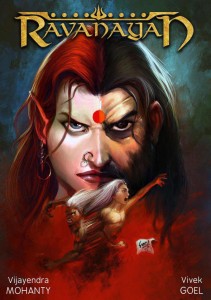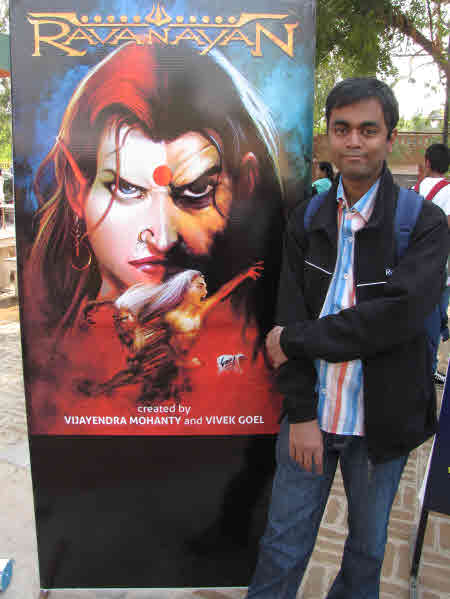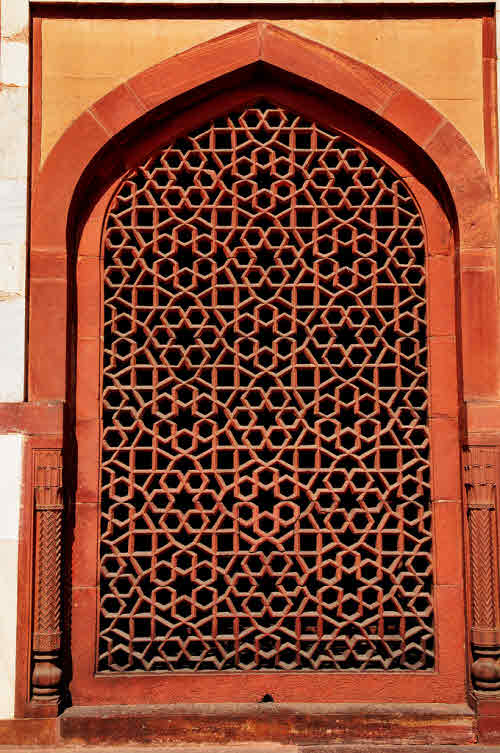Interview by Anupama Krishnakumar
Vijayendra Mohanty is an Indian comic book writer. He has written stories and scripts for publications such as Comic JUMP and COMIX.INDIA. He is the writer and co-creator of Ravanayan, a 10-issue comic book series based on the story of king Ravana of Lanka.
I know you may have answered this question at least a dozen times – but for the uninitiated, there couldn’t be a better way to begin this interview. Tell us why you decided to tell the story of Ravana.
The Ramayana is a complicated story about the nature of the world, man’s place in it, and the way we define good and evil. But too often, it is told as a simplistic moral fable about “good” triumphing over “evil”. The Indian view of the world is way more complicated (and way more beautiful) than that. The world is a diverse place and it can’t be broken down into simple little categories like good and evil. Dharma is a nuanced philosophy according to which each individual fulfills his or her function as a part of a greater whole.
Thanks to the aforementioned simplistic versions of the Ramayana, when a modern Indian thinks about Ravana, he thinks “villain”. This works on another plane as a justifier for demonising people as well. Our intention with Ravanayan is to show that the world is a complicated place and everyone has reasons for doing the things they do. If, by the time a reader has finished reading our story, he can see a bit of himself in one of Hindu mythology’s most dreaded bad guy ever, then perhaps he will also think twice before labeling the people in his life as evil; then we will consider our work as storytellers done.
What made you decide to narrate this story through a comic series? Why not a book?
Well, for one thing, the artist Vivek Goel would have been out of work. Secondly, we didn’t look for a medium after deciding upon the story. We started looking for a story after we had decided that we wanted to do a comic. The comic book, as a storytelling medium, isn’t seen as having as much value as a book (as your question shows to an extent). Both Vivek and I are big believers in the power of comics as a tool to enrich India’s story landscape. Right now, what we have is a film industry that is somewhat limited in choice of genre and has to bow to financial concerns because making a movie is not cheap. Because of this, many stories remain untold. We believe that comics can emerge as an alternative popular entertainment medium. With Ravanayan we are simply working towards that future.
How much of a role has research played in the shaping of Ravanayan? What were some of the materials you looked through for this?
For the most part, our source has been the Valmiki Ramayana. But the reason we looked to Valmiki was not because we wanted to reproduce incidents from his version of events, but because we didn’t want to. Our Ravanayan is a narrative of events that happen in the gaps of the Ramayana. So while we do not change anything in Valmiki’s original, we tell a completely new story by going behind the scenes of a story known to every Indian.
Now that two issues of the ten-part series are out, how has the response been? I am particularly curious to know how people responded to the concept of retelling an epic from the point of view of someone branded as ‘the bad’.
The response has been very heartening. So far, of the hundreds and hundreds of feedback messages we have received, only one or two can be called negative. Many picked up a copy just because they thought the concept was intriguing. I think comic book readers on the whole, are adventurous and open-minded people who don’t get uncomfortable when things take strange turns. Also, we found that not too many people are hung up about our protagonist being a “bad guy”. There were some who came to Ravanayan with hopes of seeing a sensationalist “Lord Rama exposed” sort of narrative, but I suppose they were disappointed. Ravanayan has no villains. Rama is still the heroic prince and Ravana still commits each and every mistake he did in Valmiki’s original. We haven’t flipped the hero-villain positioning. We have redefined what being a hero means.
negative. Many picked up a copy just because they thought the concept was intriguing. I think comic book readers on the whole, are adventurous and open-minded people who don’t get uncomfortable when things take strange turns. Also, we found that not too many people are hung up about our protagonist being a “bad guy”. There were some who came to Ravanayan with hopes of seeing a sensationalist “Lord Rama exposed” sort of narrative, but I suppose they were disappointed. Ravanayan has no villains. Rama is still the heroic prince and Ravana still commits each and every mistake he did in Valmiki’s original. We haven’t flipped the hero-villain positioning. We have redefined what being a hero means.
What is the challenge in writing for a medium like comics?
Too many to go into in one short answer. But mostly, it has to do with the challenges that come with any collaborative work. As a writer, my creative decisions have to factor in my artist partner Vivek Goel’s strengths and choice of style as well. This means that from beginning to end, the making of a comic book is an epic tale of compromises. We try to keep it as seamless as possible, but creating a comic book requires creators to adapt and adjust, not only with the collaborative work flow, but also to each other.
How exactly did you go about planning this series in terms of the scripting and sketching? Was the story decided first and then logically split into parts? Can you walk us through the process of how you and artist, Vivek Goel, coordinate your work?
We decided that we were going to do a comic together. But it had to be something monumental, both in terms of topic, and implementation. After we decided to make it about Ravana, we planned to have it out as a 120 page graphic novel. Later, due to economic as well as other concerns, we had to break it down into 12 16-page chapters. Vivek drew up concept sketches based on the plot synopsis we had prepared and we started to brainstorm on and off. This was a long time ago and various other projects kept getting in our way.
But eventually, we got around to working on Ravanayan again. Vivek founded his own comic book publishing company by the name of Holy Cow Entertainment and we decided to publish Ravanayan through the new brand.
Work started in full earnest soon after the publishing decision was taken. The way we work now is that I write up the scripts for individual issues — these include panel descriptions, dialogues, and other directions — and email them to Vivek. Then we discuss the story and once satisfied, Vivek starts with the drawing. Once he is done, the art goes for colouring and once that is done, it comes back to me for the lettering (all those caption boxes and speech bubbles). After lettering, I send the pages back to Vivek and after that, there is just the printer between us and the reader.
This interview cannot be complete without a few thoughts on Vivek’s work. What is it about his style that you really like and that you feel sets his approach apart? Further, what’s the sort of feedback you give Vivek for his sketches when working on the issues?
Vivek is a self-taught comic book artist who learned his craft like Ekalavya learnt archery. His style is very American and this brings a contemporary edge to Ravanayan as far as action sequences are concerned.
We both have very different approaches to the task of telling a story. Our interactions are less about telling the other person to change and more about changing ourselves to work better with each other. To this end, Vivek has had to adapt to suit my way of occasionally slow and conversation-centric scenes. I, on the other hand, have had to learn how to tell the story through (and sometimes in spite of) thick action all around.
Ravanayan is going to be a ten-part series. When is the series expected to end?
Some of our plans regarding Ravanayan have changed since we began publishing it. Reader feedback indicated that while people are loving our issues, they find themselves a little let down by the small number of pages. This is understandable since with a comic book that is only 16 pages long, the reading experience never gets a chance to mature.
We have made some changes to our publishing schedule and Ravanayan will no longer come out in issues containing single chapters. We are packing two chapters into every issue from now on and this means that the series will come to an end before the earlier estimated date. At the rate at which we are going, Ravanayan readers should see its magnificent finale sometime in January 2012.
Do you feel you can approach the other epic, The Mahabharata from a different perspective? If yes, which way would you look at it?
The entirety of the Mahabharata cannot be approached the way we have approached the Ramayana. It is a much more complicated narrative involving multiple characters with all shades of grey. No character in the Mahabharata can be called a being of light if we assess the Mahabharata’s merit by way of simplistic understanding of right and wrong.
One of our early candidates was Duryodhana himself. But we decided to go in Ravana’s direction because he is a more solid presence as far as villainous presence is concerned. In the Mahabharata, there is no one centre of all things evil like there is (allegedly) in the Ramayana. While it is possible to take individual episodes from the epic and fashion them into something new, the epic on the whole can’t be made to fit any modern mould without making serious compromises. It is simply too big.
This doesn’t mean that I would not like to try it someday, of course. Just that now is not the time.
The final question – obviously, What, after Ravanayan?
Something new, of course. And hopefully, something better. 🙂








And kudos to Anu too..for asking just the right questions and together with Mohanty..shaping this outcome. Great questions and great answers. Congratulations to Goel as well..that Cover art has captured the emotions well..and the split depiction of one entity as both good and evil like a coin with two sides..is an idea..which even though being a core fact of existence..has been sidelined by indian literature very often. i really hope to be fortunate to be able to read this book soon..
All the best for the future issues to both of you. 🙂
Kudos to Vijayendra for putting up such an impressive retelling of a famous Indian mythological lore in such an innovative manner…his interview really shows his passion for the medium…looking forward to grabbing a copy of ravanayan.